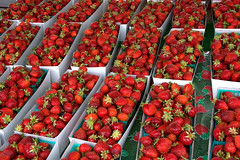Every Tuesday, I cook dinner with a friend of mine to save some money by cooking at home and improving our kitchen skills. This week is her turn at the stove, but I’m bringing strawberries for dessert. Why? Well, in the spirit of frugal cooking, imagine my excitement when I saw strawberries for 88 cents a pound at my local supermarket. I was pretty stoked, but with a little research learned that low prices for me means bad news for strawberry farmers as the height of the season approaches.
It’s the cold winter on the east coast that’s permitted Florida strawberries to flood the market, just as California’s growing season gets underway. Marketplace’s Kai Ryssdal spoke with Plant City, Florida farmer Gary Wishnatzki about the surplus.
Typically in mid-February growers will plant in the same bed spring crop like melons, eggplant, tomatoes or cucumbers, but by late March the two crops begin to compete for room and at that point the grower will just come in and twist off the strawberry plants to give the spring crop room to grow. This year the extended cold slowed the strawberry harvest down.
Savings blog WalletPop also picked up on the strawberry bounty, reporting that prices in Ohio are also low, coming in at around $2.50 per pint. WalletPop even had some suggestions of what to make if you (like me) have found yourself with a fridge full of strawberries.
How can you take advantage of the deals being offered in local groceries? One of my favorites is freezer jam, which avoids all that messy pouring of wax caps. By the same process you can make a killer ice-cream topping by thinning down the mix.
One WalletPop writer took her bounty and managed to make strawberry tacos (or galettes, if you’re more Martha).
While strawberry prices have crashed this year, the cost of land to grow them on is still high. Why is that, if real estate prices in urban and industrial areas are still dropping due to the mortgage crisis? PBS NewsHour’s Paul Solman found out why from agricultural economist Gerald Nelson:
Agricultural land is driven by future agricultural prices. And while we are off the highs of 2008, agricultural prices are still high and the expectation is that they will continue to be high.
Have you seen other unexpected deals on produce this season at your local store?

